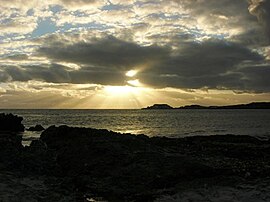Carpenter Rocks
|
Carpenter Rocks South Australia |
|||||||||||||||
|---|---|---|---|---|---|---|---|---|---|---|---|---|---|---|---|

Sunset over 'The Carpenter', from Gerloff Bay
|
|||||||||||||||
| Coordinates | 37°55′0″S 140°24′0″E / 37.91667°S 140.40000°ECoordinates: 37°55′0″S 140°24′0″E / 37.91667°S 140.40000°E | ||||||||||||||
| Population | 177 (shared with other localities in the “State Suburb of Carpenter Rocks”) (2011 census) | ||||||||||||||
| Postcode(s) | 5291 | ||||||||||||||
| Location |
|
||||||||||||||
| LGA(s) | District Council of Grant | ||||||||||||||
| Region | Limestone Coast | ||||||||||||||
| County | County of Grey | ||||||||||||||
| State electorate(s) | Mount Gambier | ||||||||||||||
| Federal Division(s) | Barker | ||||||||||||||
|
|||||||||||||||
|
|||||||||||||||
| Footnotes | Climate Adjoining localities |
||||||||||||||
Carpenter Rocks is a small coastal town located 35 km south-west of Mount Gambier in the south-east of South Australia. The area faces the Southern Ocean and is renowned for its rugged coastline which provides exceptional fishing and diving locations.
In the 2011 census, Carpenter Rocks and the western part of the adjoining locality of Pelican Point shared a population of 177. Carpenter Rocks is in the District Council of Grant local government area, the South Australian House of Assembly electoral district of Mount Gambier and the Australian House of Representatives Division of Barker.
The earliest people in the Carpenter Rocks area were the aboriginal communities from the Booandik tribe. They were scattered in small groups along the coast where they had access to an abundance of food and water. Due to disease and land dispossession the last full blooded Booandik died in 1904.
Lieutenant James Grant, when on board the HMS Lady Nelson, was the first known British person to view land known today as south eastern South Australia. On 3 December 1800, he sighted what at first he thought was four unconnected islands, but on a closer look realized they were two mountains and two capes. One of these he named Cape Banks, just west of today's township, after English Botanist - Joseph Banks. On 4 April 1802, the French explorer Nicholas Baudin aboard the ship Geographe noticed the area and made the observation:
...
Wikipedia

